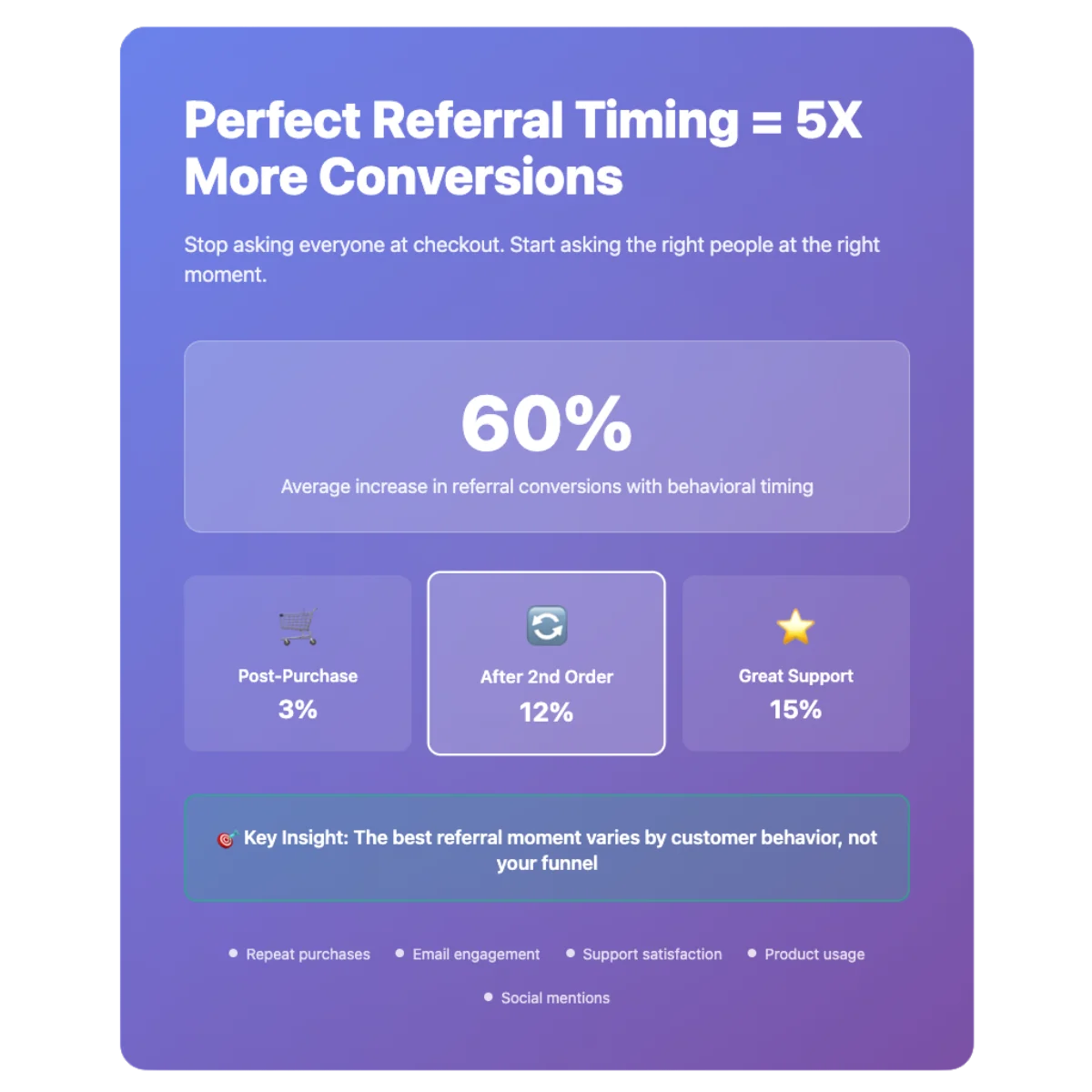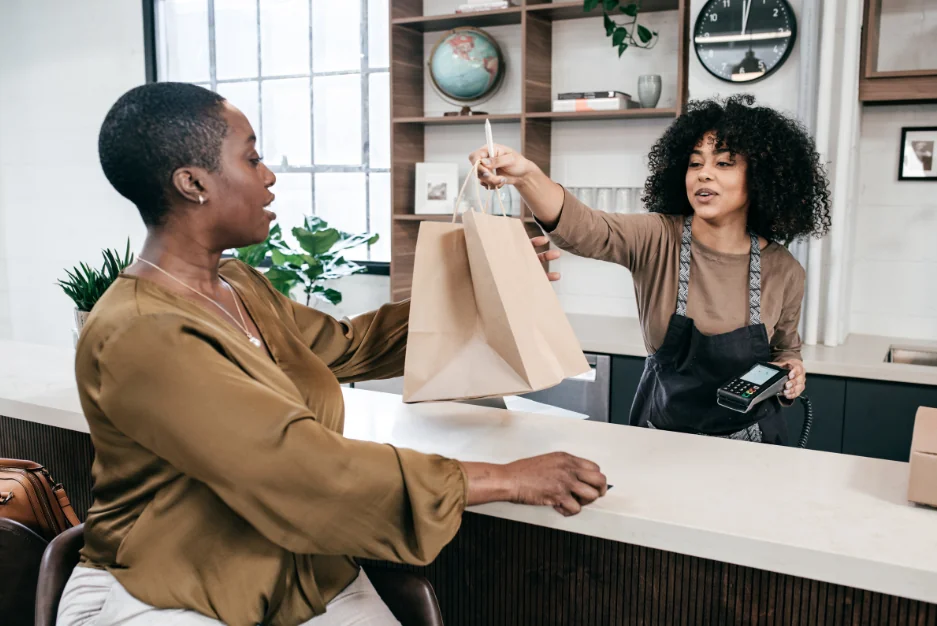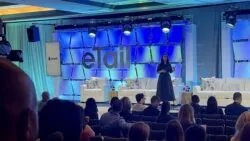We’ve all been told the same thing: the best time to ask for a referral is right after purchase. The customer is happy. The transaction is fresh. The dopamine is flowing. Makes sense, right?
Except it doesn’t always work that way.
I’ve seen brands pour resources into post-purchase referral campaigns only to watch conversion rates stall at 2-3%. Meanwhile, a simple email three weeks later, timed to when a customer reorders, pulls double-digit response rates. Same offer. Same creative. Different moment.
The truth is, the best referral moment isn’t the same for everyone. And in 2025, we finally have the tools to figure out when each customer is most likely to share.
The post-purchase myth
Post-purchase has become the default referral trigger because it’s easy to implement. The purchase event fires, the email goes out, and you move on. It’s clean. It’s measurable. And for some customers, it works.
But here’s what we’re learning: the best time to ask isn’t tied to your funnel. It’s tied to customer behavior. Some people share immediately. Others need to use the product first. Some want social proof before they recommend anything. And a growing segment will only refer after they’ve had a support interaction that impressed them.
If you’re treating every customer the same, you’re leaving money on the table.
Behavioral signals that predict advocacy
AI isn’t magic. It’s pattern recognition at scale. And when it comes to referral timing, the patterns are clearer than you’d think.
The signals that matter most include repeat purchase velocity, support ticket sentiment, email engagement rates, time spent on product pages during return visits, and social media mentions or tags. If a customer buys twice in three weeks, they’re in momentum mode. If they open every email you send, they’re engaged. If they contact support and rate the interaction highly, they trust you.
These aren’t random data points. They’re advocacy indicators. And you can use them to predict when someone is most likely to say yes to a referral ask.
We worked with a skincare brand that overlaid these signals onto their referral program. Instead of blasting every customer at checkout, they built three timing cohorts: immediate sharers got the post-purchase prompt, engaged users got a referral ask after their third email open, and advocates got personalized invites after positive support interactions. Conversion rates jumped by 60% in the first month.
Testing moment-based triggers vs. funnel triggers
Here’s the shift: stop thinking about your funnel and start thinking about customer state.
Funnel-based triggers are event-driven. They fire when someone completes an action like checkout, account creation, or first login. They’re reliable but impersonal. Moment-based triggers are behavior-driven. They fire when a customer hits a threshold like engagement score, repeat purchase, or high product usage.
The difference matters because customers don’t live in your funnel. They live in their own journey. And that journey doesn’t always align with your checkout flow.
Start small. Pick one segment (repeat buyers, for example) and test moment-based timing against your default post-purchase flow. Measure conversion rates, not just participation. You’re looking for quality referrals, not volume.
Building this without a data science team
You don’t need a machine learning engineer to make this work. Most modern referral platforms and customer data tools already surface the signals you need.
Start with what you have. If you’re using a CDP or email platform, you already have engagement scoring. If you’re running a loyalty program, you have repeat purchase data. If you’re using a helpdesk tool, you have support sentiment scores. The hard part isn’t collecting the data. It’s deciding what to do with it.
Build simple rules first. If a customer has opened three emails in seven days, trigger a referral invite. If someone has made two purchases in 30 days, send a personalized share prompt. If a support ticket closes with a five-star rating, follow up with a referral ask within 24 hours.
Once these rules are live, watch what happens. Some will perform. Some won’t. The winners become your benchmarks. Then you layer in more sophistication over time.
AI tools can help accelerate this process. Platforms like Talkable are already integrating predictive timing into their workflows, using historical data to recommend optimal send windows per customer. But even without those tools, you can make progress with basic segmentation and testing.
When AI actually helps
AI shines when you have volume. If you’re running 10,000 referral invites a month, manual segmentation breaks down fast. That’s where predictive models come in.
The best systems look at historical referral data and identify which combinations of behaviors led to conversions. Then they apply those patterns forward, scoring each customer on referral readiness in real time. When someone crosses the threshold, the system triggers the invite automatically.
This is already happening at scale. Brands are using AI to shift referral timing by days or even weeks per customer, and the results are measurable. Higher conversion rates. Better quality referrals. Lower unsubscribe rates because the ask feels relevant, not random.
The key is starting with clean data. If your referral tracking is messy or your attribution model is broken, AI won’t fix it. It’ll just scale the problem. Get your foundation right first. Then let the algorithms do their job.
What to do this week
Pick your highest-value customer segment and map their journey from first purchase to advocacy. Where are the engagement spikes? When do they come back? What actions correlate with referrals?
Next, build one test. Take that segment and split it. Send half your normal post-purchase referral prompt. Send the other half a moment-based prompt tied to a behavioral signal like second purchase or high email engagement.
Run it for 30 days. Measure conversion rates and referral quality, not just participation. If the moment-based group outperforms, you’ve found your wedge. Scale it.
The brands that win in 2026 won’t be the ones asking everyone at the same time. They’ll be the ones asking the right people at the right moment. And they’ll be using data to figure out the difference.
About the Author:
Jeremy Foreshew is a full-stack marketer with deep expertise in customer-led growth. As Head of Marketing at Talkable, he helps DTC and eCommerce brands turn their customers into their most powerful acquisition channel. Jeremy writes about referral strategy, retention, and the future of word-of-mouth marketing. He has been featured in Forbes, TechCrunch, and HuffPost.




